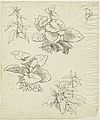Adolf Friedrich (painter)
Gustav Adolf Friedrich (born December 23, 1824 in Dresden ; † January 4, 1889 ibid) was a German painter and the son of Caspar David Friedrich .
Life
Adolf Friedrich was born as the fourth child of the painter Caspar David Friedrich and his wife Caroline . The family encouraged his artistic talent. At the age of 15 he was able to start studying at the Dresden Art Academy , where he took subjects such as landscape and animal drawing as well as portrait and history painting . His teachers were Ludwig Richter , Friedrich Matthäi , Ferdinand Hartmann , Carl Christian Vogel von Vogelstein and Johann Karl Ulrich Bähr . After the death of his father in May 1840, the student was under the tutelage of his uncle Christoph Friedrich Bommer (1778–1846) until he graduated from the Academy in 1846 . In 1841 he took part for the first time with a work in the Academic Exhibition in Dresden, from 1861 to 1889 his pictures were regularly represented there.
In 1856, the painter married Caroline (Therese) Lehmann (1828–1914), daughter of the innkeeper Johann Gottlob Lehmann from Dresden. Caroline later became a well-known flower painter with participation in the academic exhibitions. The only son Harald Friedrich (1858–1933) emerged from the marriage, who also studied art and became a university lecturer in Hanover. Friedrich lived in Dresden and the surrounding area all his life, but made numerous trips with his family to Venice, Paris, Holland, Denmark, Tyrol, Upper Bavaria, Switzerland and major German cities.
plant
Friedrich worked as a portrait , genre and landscape painter, produced paintings, drawings, watercolors and lithographs . In the middle of the 19th century he was considered a specialist in horse painting. Until the end of his studies, the painter orientated himself stylistically clearly on the work of his father's landscapes, and as a boy had also copied his studies of nature. Several family portraits are due to him. From around 1850 onwards he served the contemporary taste of historicizing and idealizing landscapes, later painting mainly scenes from the rural milieu.
In contrast to his father, Friedrich was able to make a living from selling his genre paintings. The Saxon Art Association bought many of his works, and in 1877 the Royal Picture Gallery also acquired a picture. His templates for the woodcutter workshop around Hugo Becker in Dresden are known, among other things the representation of cattle breeds. Friedrich left behind a work of several hundred paintings, many of which are still present in the art trade today. His works in the museum are mainly in the Pomeranian State Museum in Greifswald and in the Dresden State Art Collections .
Adolf Friedrich: The Augustusbrücke Dresden, around 1843
literature
- Caspar David Friedrich Society V. Greifswald: The artists of the Friedrich family . Exhibition in the Caspar David Friedrich Center Greifswald, 2014, pp. 5–7, 9, 10, 33
- Ulrich Thieme, Felix Becker, Hans Vollmer: General Lexicon of the Visual Artists. From antiquity to the present. Sailor 1999
- Dresden. From the Royal Art Academy to the College of Fine Arts. 1764-1889. Dresden 1990
Web links
Individual evidence
- ↑ Royal Technical University of Hanover, files relating to Professor Harald Friedrich
| personal data | |
|---|---|
| SURNAME | Friedrich, Adolf |
| ALTERNATIVE NAMES | Friedrich, Gustav Adolf (full name) |
| BRIEF DESCRIPTION | German painter, son of Caspar David Friedrich |
| DATE OF BIRTH | December 23, 1824 |
| PLACE OF BIRTH | Dresden |
| DATE OF DEATH | January 4, 1889 |
| Place of death | Dresden |







